Terence Rorke
- Frank van Brunschot
- May 23
- 3 min read
Updated: Aug 22
Terence Rorke was an early colonial cabinetmaker and retailer based on Queen Street in Brisbane. This drawing room suite was commissioned or owned by Robert and Alice Pollock, who were affluent owners of the Lady Mary Gold Mine in Gympie around 1870.

The Royal Queensland Historical Society are the custodians of this furniture. They engaged my services to conserve, restore, and repair these items for exhibition at the Commissariat Store Museum, located at 115 William Street, Brisbane. The drawing room suite includes a Loo table, six balloon-backed chairs, a chaise longue, a grandfather and grandmother chair, and a state chair.

This article centers on the conservation and restoration of the Loo table. It explores a variety of techniques, aiming to elaborate on the diverse methods employed to preserve the historical integrity of the pieces while ensuring their structural stability for enjoyment by future generations.

The above phots shows the underside of the top, (in the process of being disassembled). A skirt runs around the perimeter and structural bearers are fixed to the top in a configuration which support the top as well as securing the base and it's tilting mechanism to it.

The top is made up out of three wide boards, edge joined together with dowels. The glue joins had failed quite some time ago and there was a two to three millimetre gap from timber shrinkage and movement. The edge joins were re-surfaced and re-fitted with a number 8 jointing plan. A very small amount of the original timber was removed, the bare minimum, just enough to flatten the surface.

Sash clamps are used to glue up the top. The old dowels were removed and new hardwood dowels fitted into the existing holes.

The photo above illustrates how the old bearers were utilised to salvage some Yellowwood timber. Yellowwood, a beautiful material, is no longer available. The balloon-backed chairs, which were part of the suite, had numerous old repairs. Unfortunately, Queensland Maple was used for these repairs, and the original Yellowwood was long gone. Since the bearers were solid Yellowwood and original to the suite, I decided to salvage some of the timber for the chair repairs. The old surfaces of the bearers were cut away and laminated onto replacement material, leaving a usable section of Yellowwood that was used to repair the chairs. This technique worked well and preserved the historic integrity of the furniture.

The balloon backed chair had quite a lot of lost material, (from old repairs) and as it was in a visually prominent place it was important to use the correct species for the repairs. The above photo shows how the salvaged timber was used.

This photo shows the bearers being re-installed. Although the two cross members have been replaced, they look identical to how they were as the three original exposed surfaces have been retained.

The skirt being re-fitted. The timber where the screws threaded into was broken and damaged. A patch of replacement timber was neatly inset, allowing the thread of a wood screw to be re-cut and securely hold the top to the base.

The above photo shows the furniture completed, prior to upholstery work. Although the furniture dose not look radically different to before the conservation/ restoration there are a lot of unseen techniques and processes behind it. All work, repairs, treatments and intervention have be done inline with a conservation ethic. The furniture is now on display, it presents well and looks nicely it's age.


